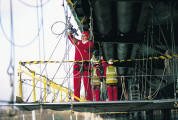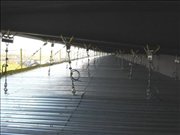Ryan_Berry
Member
Good evening to all the engineers out there.
I am currently working on a job whereby there is a load of just 35kg falling from a height of 2m. I have calculated the impact force (average) based on the velocity just before impact and the kinetic energy. The calculations for this are as follows:
Mass = 35kg
h = 2m
Velocity before impact = √2gh = √2 x 9.81 x 2.000m = 6.26m/s
Kinetic energy just before impact = 0.5 x 35 x 6.26² = 686J
The value above does not satisfy the conditions for determining the impact force as we don't know how far the 'object' has travelled upon impact. Thus, I have calculated the deflection of a single tube (which we are using as protection as punching shear on boards is an issue and doubling them up is not possible as they will not act compositely in punching shear) which is given by:
Deflection upon impact = PL³/48EI = (0.686 x 10^3 x 1.166³ / 48 x 210 x 10^6 x 13.8 x 10^-8) = 0.781mm
I have then used the work-energy principle to determine an average impact force of 878361N = 878.361kN. As we all know this is a massive load and under such load a tube will fail.
In order for the system to work I will require the object to travel 70mm i.e. the tubes will need to deflect 70mm which if I do this the tube will fail under the applied load of approximately 10kN.
Has anyone had a situation similar to this before and can shed any light on a suitable solution as I have thought of the following items but there are issues with all of them:
- Netting over the handrails as a catenary cable. This would not be up to much as the 'sharp' objects would potentially tear the debris netting reducing some of the velocity / impact but not by much. Plus this is extremely difficult to prove as we don't quite know what will fall on the debris net to start with.
- Polystyrene blocks - with a sufficient depth say 200mm the impact force would be dissipated. This is a strong favourite. ??
- A sacrifical level of boards on the top chord of the beam with beam lacings on the bottom. The boards will fail and bottom level trapping the items. A bit sceptical with this one.
I look forward to any ideas you have.
Regards,
Ryan
I am currently working on a job whereby there is a load of just 35kg falling from a height of 2m. I have calculated the impact force (average) based on the velocity just before impact and the kinetic energy. The calculations for this are as follows:
Mass = 35kg
h = 2m
Velocity before impact = √2gh = √2 x 9.81 x 2.000m = 6.26m/s
Kinetic energy just before impact = 0.5 x 35 x 6.26² = 686J
The value above does not satisfy the conditions for determining the impact force as we don't know how far the 'object' has travelled upon impact. Thus, I have calculated the deflection of a single tube (which we are using as protection as punching shear on boards is an issue and doubling them up is not possible as they will not act compositely in punching shear) which is given by:
Deflection upon impact = PL³/48EI = (0.686 x 10^3 x 1.166³ / 48 x 210 x 10^6 x 13.8 x 10^-8) = 0.781mm
I have then used the work-energy principle to determine an average impact force of 878361N = 878.361kN. As we all know this is a massive load and under such load a tube will fail.
In order for the system to work I will require the object to travel 70mm i.e. the tubes will need to deflect 70mm which if I do this the tube will fail under the applied load of approximately 10kN.
Has anyone had a situation similar to this before and can shed any light on a suitable solution as I have thought of the following items but there are issues with all of them:
- Netting over the handrails as a catenary cable. This would not be up to much as the 'sharp' objects would potentially tear the debris netting reducing some of the velocity / impact but not by much. Plus this is extremely difficult to prove as we don't quite know what will fall on the debris net to start with.
- Polystyrene blocks - with a sufficient depth say 200mm the impact force would be dissipated. This is a strong favourite. ??
- A sacrifical level of boards on the top chord of the beam with beam lacings on the bottom. The boards will fail and bottom level trapping the items. A bit sceptical with this one.
I look forward to any ideas you have.
Regards,
Ryan



